I'm Peter's brother Stephen, and I have set up this page to raise money to build a cabin/chalet to safely house Peter away from electrical fields which he is effectively allergic too.
We hope you will take time to read why exactly Peter needs special housing (see the section below) and we would like to give our thanks in advance for any donations received.
PETER'S STORY
Peter Lloyd is a 42 year old disabled resident of Cardiff. He suffers from a neuromuscular medical condition called mitochondrial disease http://mda.org/disease/mitochondrial-myopathies/overview, which affects the body's ability to produce energy that is needed for cells to function. This condition has led to Peter having problems such as muscle wasting, muscle weakness, exertional intolerance, stroke-like episodes, partial paralysis, hearing system defects, visual system defects, cognitive defects, difficulty swallowing, difficulty breathing and nerve problems. For the last 3 years he has effectively been bed-bound and relies on full time agency care in order to live independently.
Peter is also unfortunate in that he suffers from two other little known illnesses; Multiple Chemical Sensitivity or MCS http://www.allergyuk.org/chemical-sensitivity/chemical-sensitivity and Electromagnetic Hypersensitivity or EHS http://www.es-uk.info/ .
MCS is a condition whereby everyday chemicals can cause severe illness. For example fumes from paints, solvents, burnt gas or even paraffin wax candles can cause debilitating symptoms. EHS is a condition which can develop when people are exposed to things like computers, cordless phones, low energy lighting, mobile phones, mobile phone masts, power lines, smart meters, substations and WIFI. EHS is often progressive and can progress to a level whereby a person is so hypersensitive that they have to live life avoiding exposure to anything electrical. It is also common for people with EHS to develop MCS, and vice-versa.
EHS is a disability that is extreme in its nature and management. It means having to avoid people because everybody has a mobile phone. It means having to endure pre-industrial living conditions such as no electric lighting, no hot running water, no domestic appliances (washing machines, fridge/freezer etc) and also being denied the conveniences of modern technology such as telephones, mobiles, computers/Internet, television or even radio. But most of all living in the UK you need some form of heating.
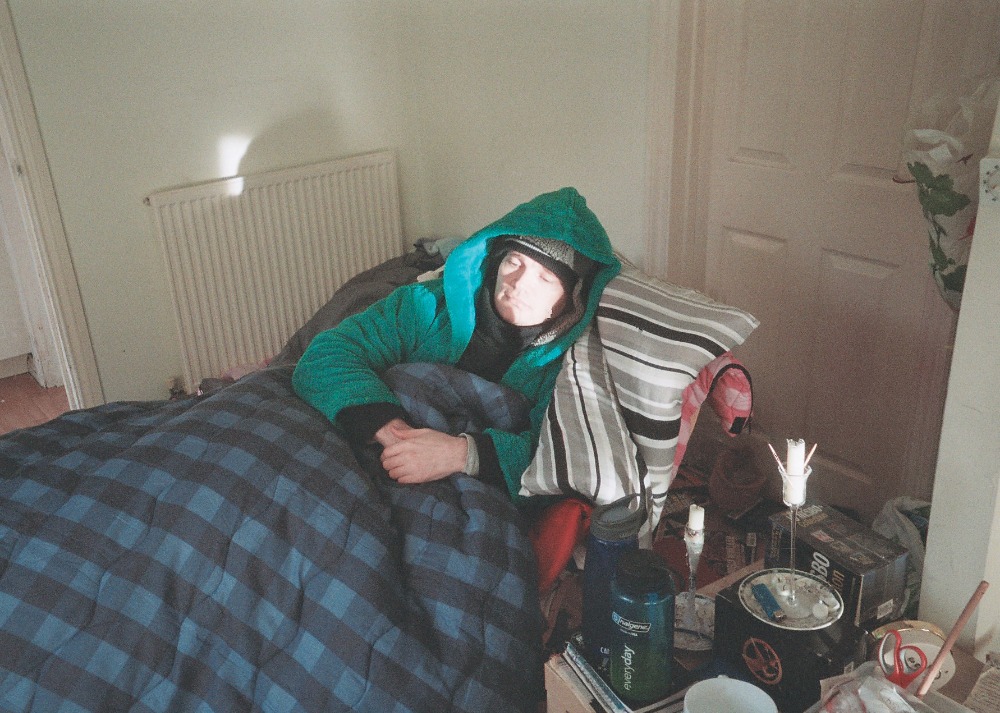 Above - Peter uses many layers of sleeping bags to survive with no heating
Above - Peter uses many layers of sleeping bags to survive with no heating
Due to the fact the he also suffers from MCS and mitochondrial disease (Peter is intolerant to fumes from calor gas and is immobile), the only heating system that would be suitable is a non-electric oil fired Aga/Rayburn multiple-application stove, vented to atmosphere. It is for this reason - along with the need for a detached property in a semi-rural/rural location, away from other houses - that finding another rental accommodation that could be heated, is unlikely to happen.
The consequences to Peter's health if he were to be unsuitably housed would be dramatic. For Peter, all three of the above conditions and their symptoms are inter-linked in that chemical or electrical exposures trigger further progression of his mitochondrial disease (studies have demonstrated this link). If Peter were to be housed in a semi-detached property/flat, he would experience unrelenting acute exposure from the neighbouring homes (mobile phones, WIFI, mains electric, smart meters etc). The combined effect of the severe EHS symptoms this would produce and the mitochondrial symptoms that this would induce would result in levels of disability/illness (and pain) that would render continued home care in a non-electrical environment, unworkable. This would inevitably lead to hospitalisation whereby medical interventions (medication that would cause unpredictable side effects due to MCS, electrical equipment to artificially support his breathing, in addition to the high EMF environment of a hospital) would cause a downward spiral that in a worst-case scenario could prove fatal, such a scenario desperately needs to be avoided.
The need for Peter to be re-housed in suitable accommodation is now critical. With the roll out of smart meters this year, and the cumulative effects of living through repeated winters without any form of heating; all aspects of Peter's health have rapidly deteriorated this year. The complex interrelation between the conditions he suffers from is further exemplified by the addition of symptoms involving upper and lower motor neurons. Two doctors have now expressed the opinion that he may also have developed a type of motor neuron disease. There are associations in the literature with EMF exposure and several recognised neurological conditions, and motor neuron disease is one of these.
Peter has been diagnosed by two different doctors who have specialist knowledge in the field of EHS. His EHS - which has been described as "exceptionally severe" and "unusually severe" - cannot be treated in any conventional sense. The only intervention that would reduce his EHS symptoms (and consequently reduce the symptoms/progression of all his medical conditions) is for him to reduce his exposure to electromagnetic fields as much as possible and this can only be achieved with the provision of a detached property in a semi-rural/rural location, away from other houses and people.
HOUSING
After a rapid deterioration in his health in 2009, Peter contacted Cardiff County Council and he was put on the priority housing list. In 2013 his landlady served him with notice to quit her property. Peter was then assessed and confirmed as being "involuntary homeless" which meant that the Council had a legal duty to provide him accommodation that was suitable to meet his health needs. However the Council offered him the same semi-detached property in the middle of the city, flanked by two mobile phone masts (both masts were within 112m, a distance where the radiation produced by these masts is at its highest), that Peter had already declined only months earlier. Following the advice of his solicitor, he again declined this housing offer as unsuitable to meet his health needs and he appealed against the decision of this housing offer. In their response - and whilst fully accepting that he suffers from EHS - the Council maintained that their offer of housing was indeed suitable and would not negatively affect Peter's health. As a result of Peter's refusal to accept the unsuitable offer of housing, the Council have classified Peter as being "voluntary homeless" which means that they have no further legal duty to rehouse him.
He was due to be evicted on the 21st October 2014, but due to the support of the South Wales Echo http://www.walesonline.co.uk/news/wales-news/electromagnetic-hypersensitivity-means-peter-lloyd-7948249 his landlady granted him a last minute reprieve in exchange for a financial settlement. Peter now has until the 14th February 2015 - which is the new eviction date - in order to find a detached rental property similar to his current housing in order to avoid eviction/hospitalisation. Whilst this does not solve Peters housing crisis (no heating or hot water available in a rental with the mains electricity off) it would allow time to raise the funds to purchase a prefabricated chalet/cabin so that Peter can finally have some quality of life. Whilst they have no statutory obligation, it is hoped that the council will help in the provision of a plot of land on which to build a chalet/cabin because of their long association and awareness of the difficulties involved with suitably rehousing Peter.
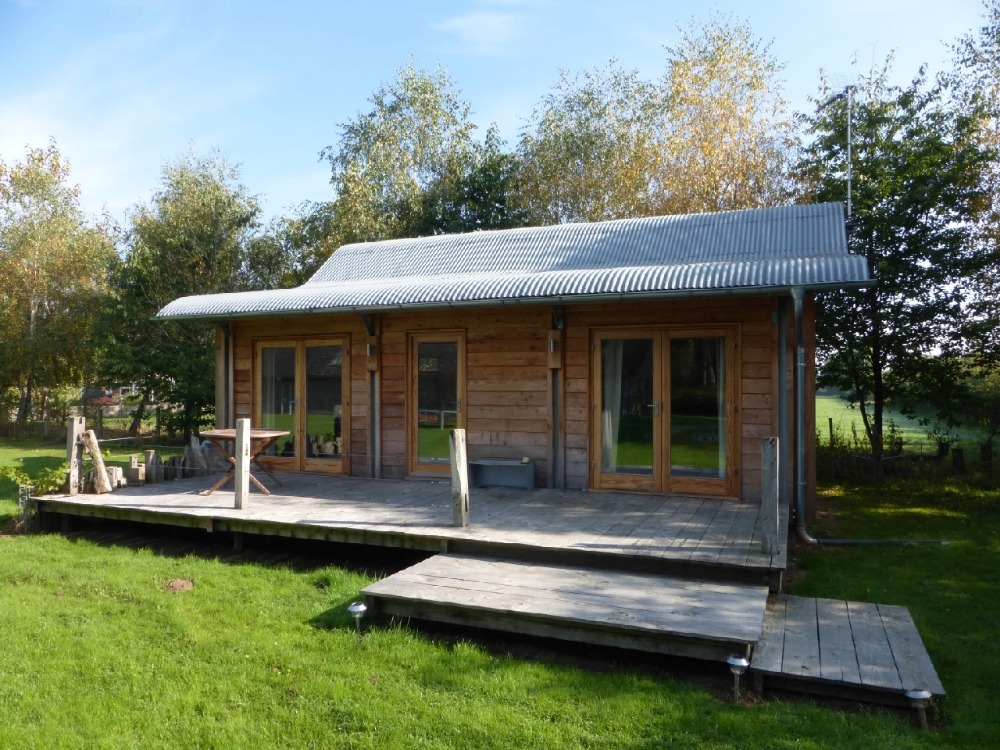 Above - An example of a suitable Cabin/chalet built by Morphut.
Above - An example of a suitable Cabin/chalet built by Morphut.
Raising money for: Peter's medical advisers have recommended a prefabricated cabin/ chalet that can be quickly assembled on a suitably located plot of land, and that the cabin has enough interior space for wheelchair use. The 3-bay cabin from http://www.morphut.co.uk/ meets these requirements, and this is what the money is being raised for.
The target: Our target is £43,000. In the event of fatality, all money raised at that point will be given to charity.
What Peter is doing: In order to show his gratitude for any donations received, Peter has pledged to spend the next 3 and a half months living on a chair in his kitchen. He has pledged not to use any electrical devices and to switch his mains electric off for the duration of the challenge. He will strip wash in temperatures as low as 3 degrees and will survive without any form of heating whatsoever. The only assistance he will receive will be from his electricalallergy challenge team (otherwise known as his carers) who will bravely and selflessly endure the freezing conditions in order to provide warm meals, drinking water and assistance with personal care.
Thank you for reading this profile.
Below - Peter's story covered in local and national press. I will update this each time Peter's story appears in the press.
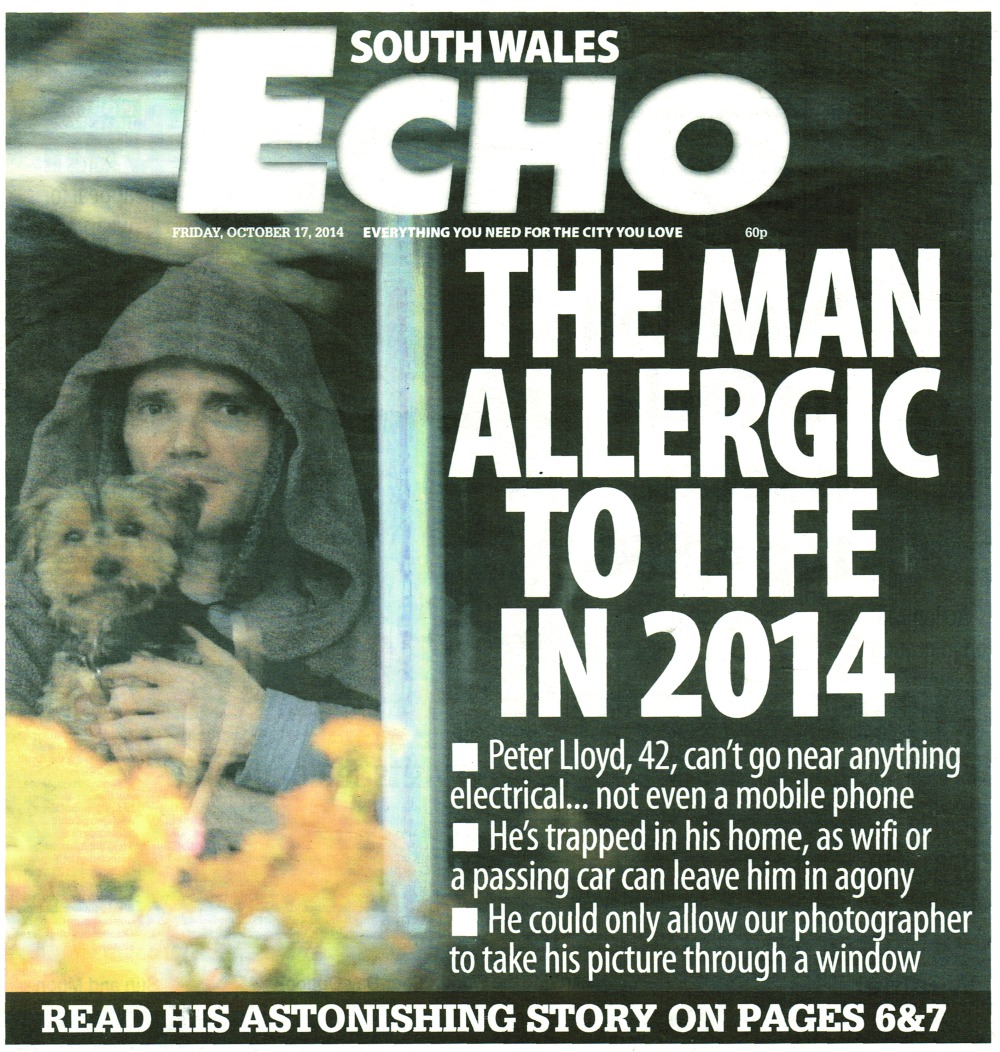
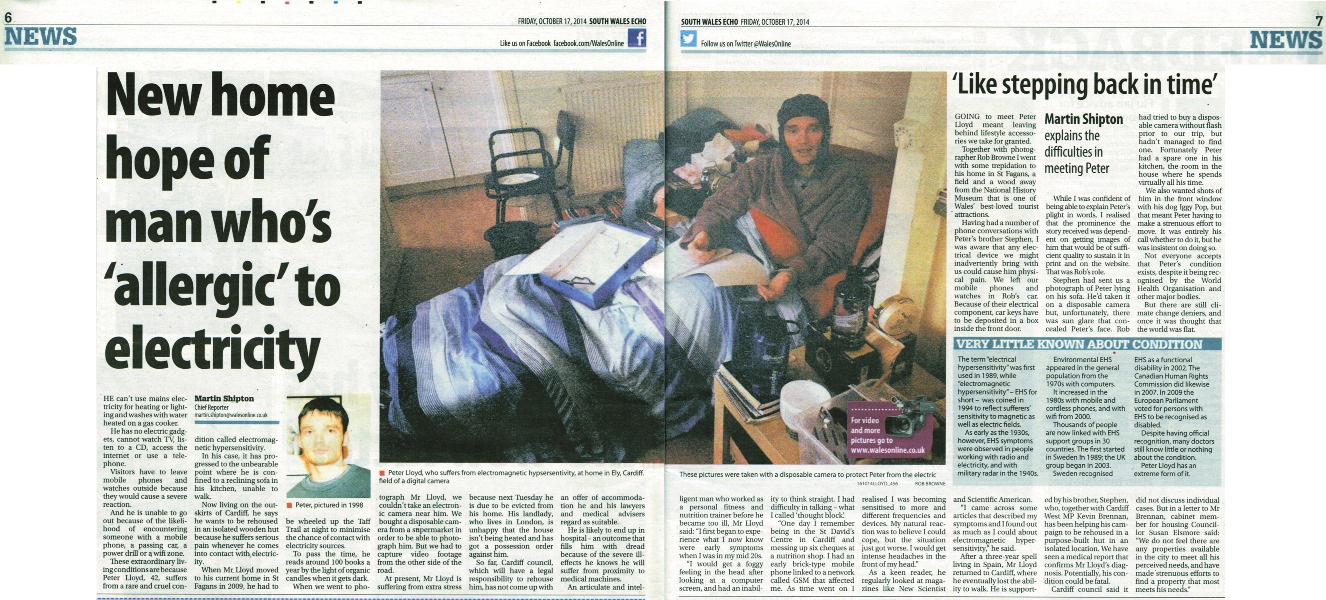
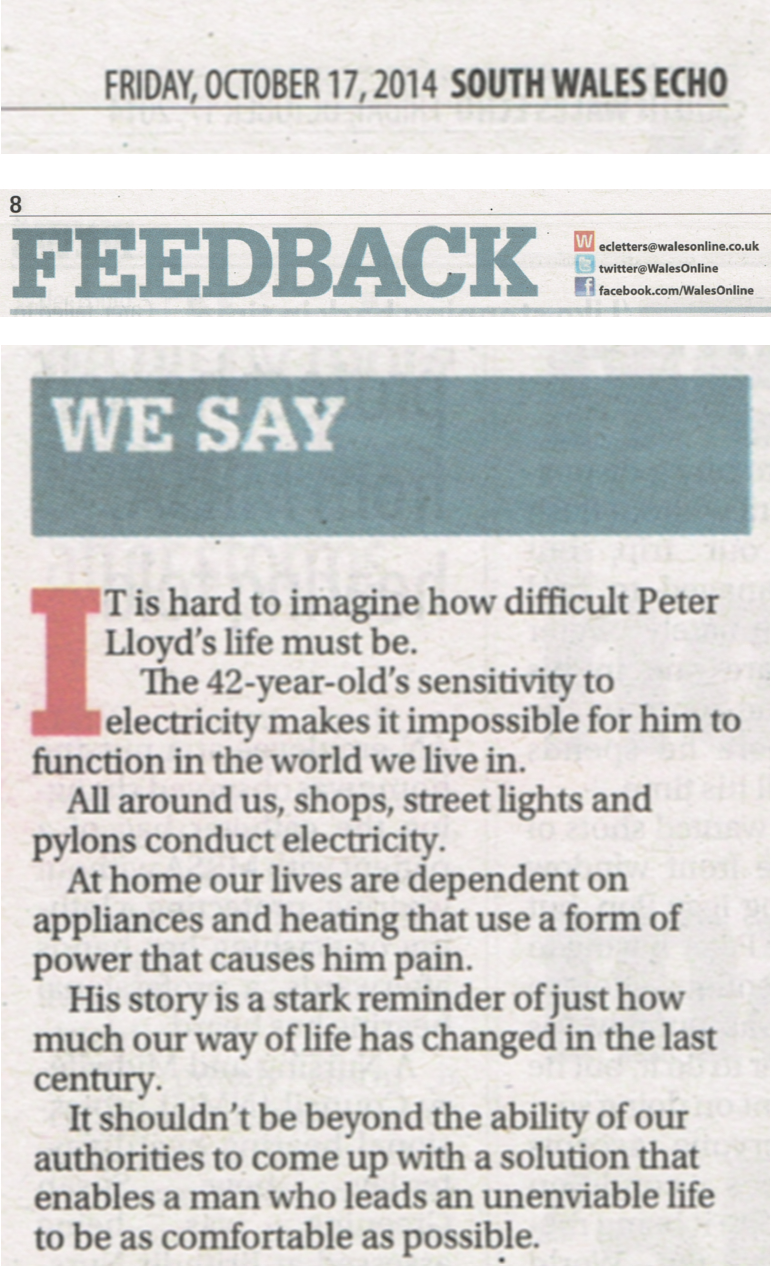
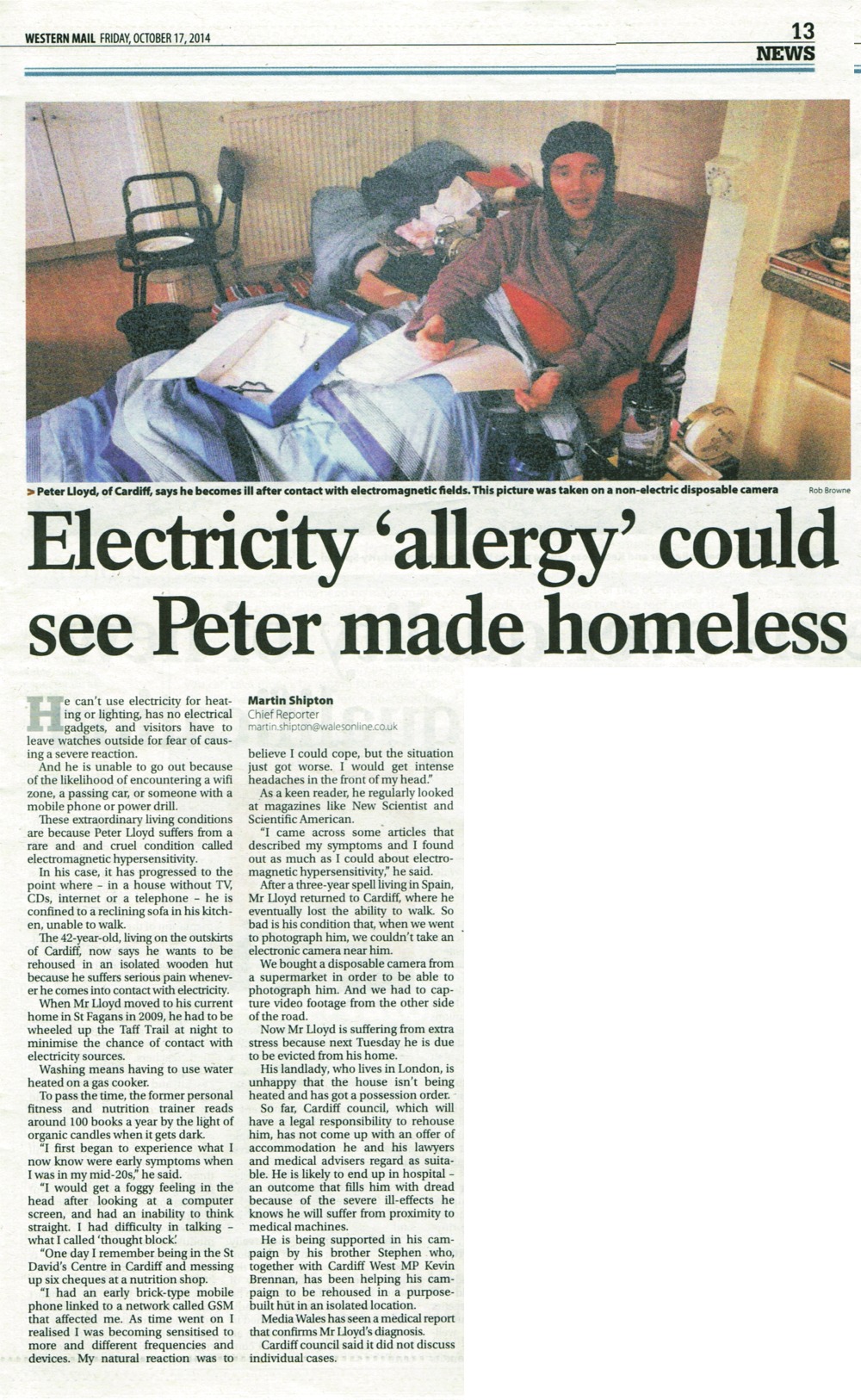

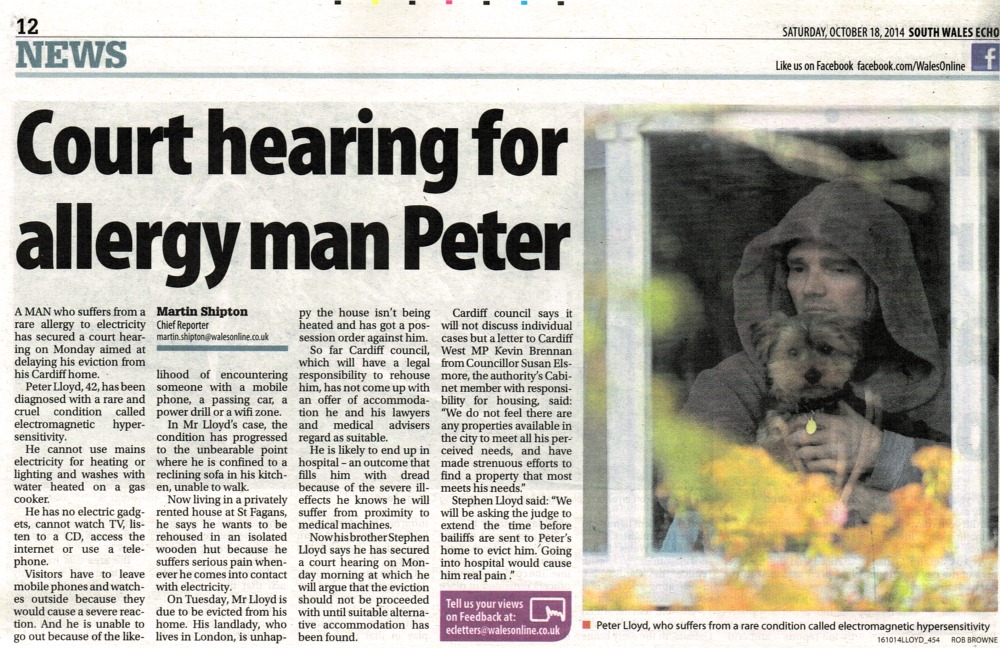
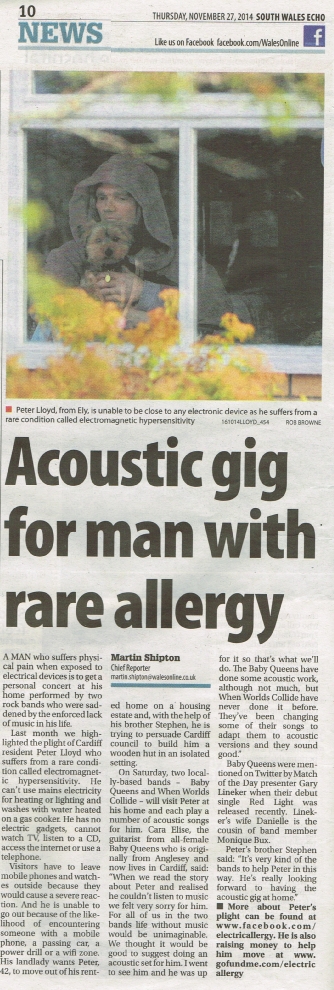
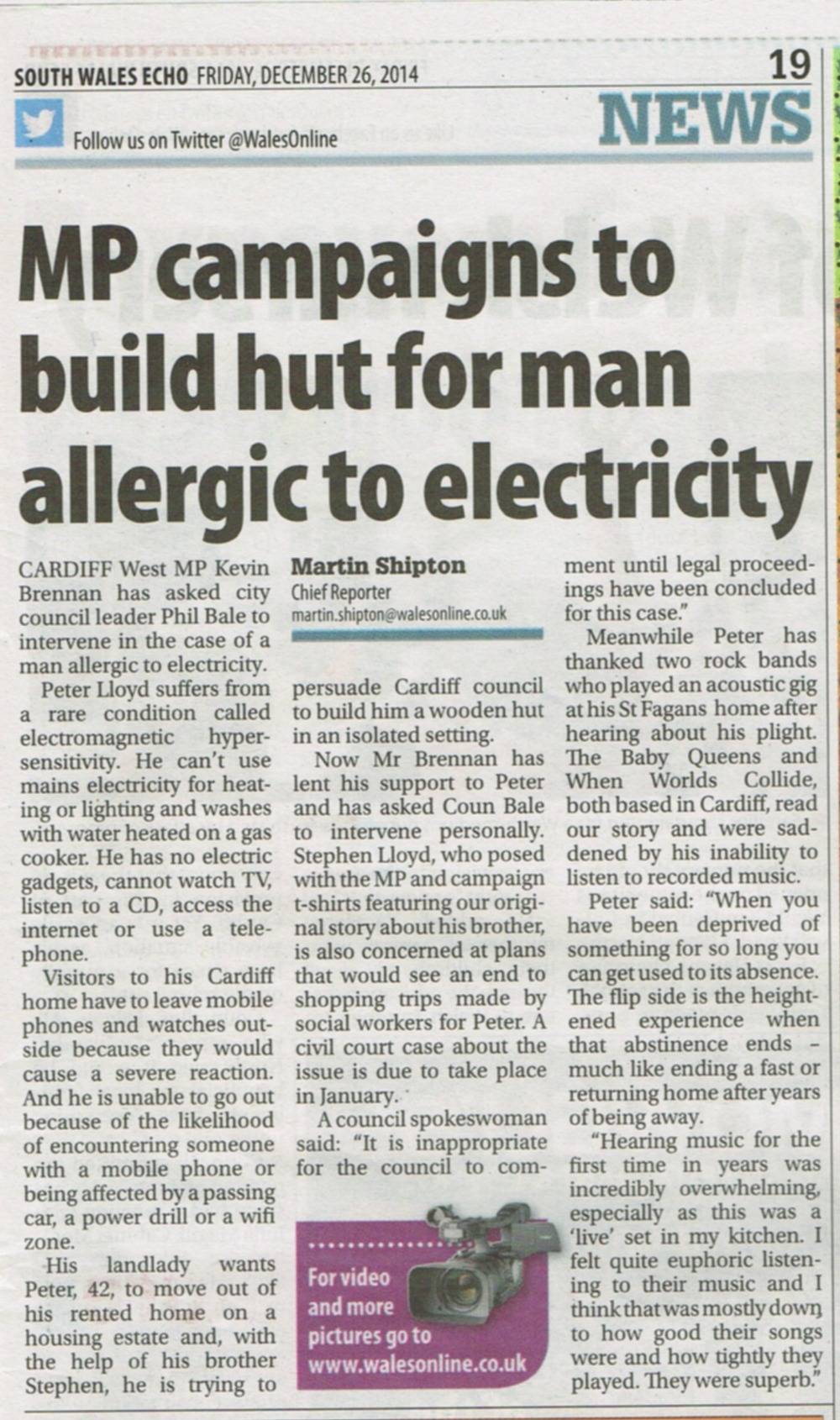
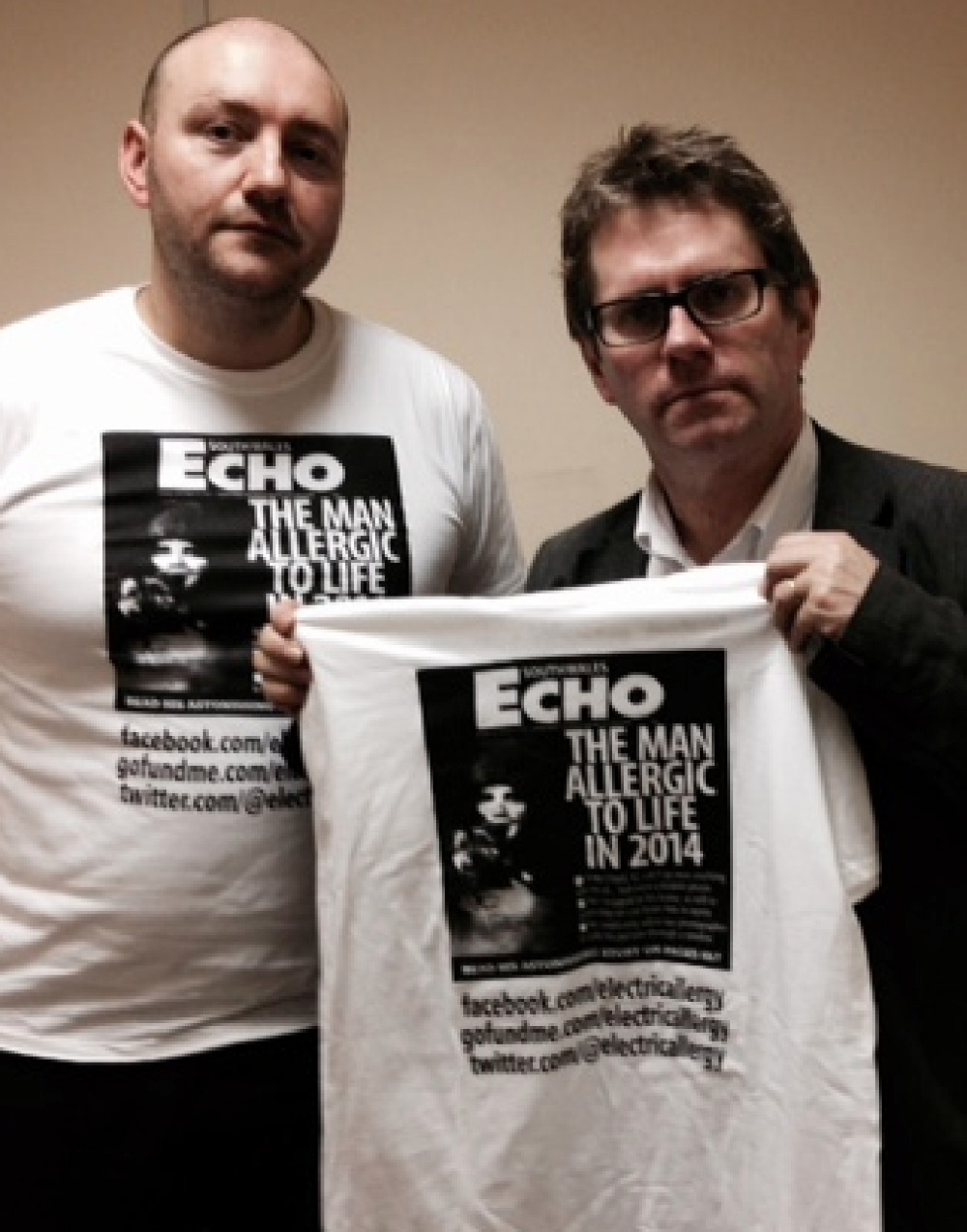
We hope you will take time to read why exactly Peter needs special housing (see the section below) and we would like to give our thanks in advance for any donations received.
PETER'S STORY
Peter Lloyd is a 42 year old disabled resident of Cardiff. He suffers from a neuromuscular medical condition called mitochondrial disease http://mda.org/disease/mitochondrial-myopathies/overview, which affects the body's ability to produce energy that is needed for cells to function. This condition has led to Peter having problems such as muscle wasting, muscle weakness, exertional intolerance, stroke-like episodes, partial paralysis, hearing system defects, visual system defects, cognitive defects, difficulty swallowing, difficulty breathing and nerve problems. For the last 3 years he has effectively been bed-bound and relies on full time agency care in order to live independently.
Peter is also unfortunate in that he suffers from two other little known illnesses; Multiple Chemical Sensitivity or MCS http://www.allergyuk.org/chemical-sensitivity/chemical-sensitivity and Electromagnetic Hypersensitivity or EHS http://www.es-uk.info/ .
MCS is a condition whereby everyday chemicals can cause severe illness. For example fumes from paints, solvents, burnt gas or even paraffin wax candles can cause debilitating symptoms. EHS is a condition which can develop when people are exposed to things like computers, cordless phones, low energy lighting, mobile phones, mobile phone masts, power lines, smart meters, substations and WIFI. EHS is often progressive and can progress to a level whereby a person is so hypersensitive that they have to live life avoiding exposure to anything electrical. It is also common for people with EHS to develop MCS, and vice-versa.
EHS is a disability that is extreme in its nature and management. It means having to avoid people because everybody has a mobile phone. It means having to endure pre-industrial living conditions such as no electric lighting, no hot running water, no domestic appliances (washing machines, fridge/freezer etc) and also being denied the conveniences of modern technology such as telephones, mobiles, computers/Internet, television or even radio. But most of all living in the UK you need some form of heating.
 Above - Peter uses many layers of sleeping bags to survive with no heating
Above - Peter uses many layers of sleeping bags to survive with no heatingDue to the fact the he also suffers from MCS and mitochondrial disease (Peter is intolerant to fumes from calor gas and is immobile), the only heating system that would be suitable is a non-electric oil fired Aga/Rayburn multiple-application stove, vented to atmosphere. It is for this reason - along with the need for a detached property in a semi-rural/rural location, away from other houses - that finding another rental accommodation that could be heated, is unlikely to happen.
The consequences to Peter's health if he were to be unsuitably housed would be dramatic. For Peter, all three of the above conditions and their symptoms are inter-linked in that chemical or electrical exposures trigger further progression of his mitochondrial disease (studies have demonstrated this link). If Peter were to be housed in a semi-detached property/flat, he would experience unrelenting acute exposure from the neighbouring homes (mobile phones, WIFI, mains electric, smart meters etc). The combined effect of the severe EHS symptoms this would produce and the mitochondrial symptoms that this would induce would result in levels of disability/illness (and pain) that would render continued home care in a non-electrical environment, unworkable. This would inevitably lead to hospitalisation whereby medical interventions (medication that would cause unpredictable side effects due to MCS, electrical equipment to artificially support his breathing, in addition to the high EMF environment of a hospital) would cause a downward spiral that in a worst-case scenario could prove fatal, such a scenario desperately needs to be avoided.
The need for Peter to be re-housed in suitable accommodation is now critical. With the roll out of smart meters this year, and the cumulative effects of living through repeated winters without any form of heating; all aspects of Peter's health have rapidly deteriorated this year. The complex interrelation between the conditions he suffers from is further exemplified by the addition of symptoms involving upper and lower motor neurons. Two doctors have now expressed the opinion that he may also have developed a type of motor neuron disease. There are associations in the literature with EMF exposure and several recognised neurological conditions, and motor neuron disease is one of these.
Peter has been diagnosed by two different doctors who have specialist knowledge in the field of EHS. His EHS - which has been described as "exceptionally severe" and "unusually severe" - cannot be treated in any conventional sense. The only intervention that would reduce his EHS symptoms (and consequently reduce the symptoms/progression of all his medical conditions) is for him to reduce his exposure to electromagnetic fields as much as possible and this can only be achieved with the provision of a detached property in a semi-rural/rural location, away from other houses and people.
HOUSING
After a rapid deterioration in his health in 2009, Peter contacted Cardiff County Council and he was put on the priority housing list. In 2013 his landlady served him with notice to quit her property. Peter was then assessed and confirmed as being "involuntary homeless" which meant that the Council had a legal duty to provide him accommodation that was suitable to meet his health needs. However the Council offered him the same semi-detached property in the middle of the city, flanked by two mobile phone masts (both masts were within 112m, a distance where the radiation produced by these masts is at its highest), that Peter had already declined only months earlier. Following the advice of his solicitor, he again declined this housing offer as unsuitable to meet his health needs and he appealed against the decision of this housing offer. In their response - and whilst fully accepting that he suffers from EHS - the Council maintained that their offer of housing was indeed suitable and would not negatively affect Peter's health. As a result of Peter's refusal to accept the unsuitable offer of housing, the Council have classified Peter as being "voluntary homeless" which means that they have no further legal duty to rehouse him.
He was due to be evicted on the 21st October 2014, but due to the support of the South Wales Echo http://www.walesonline.co.uk/news/wales-news/electromagnetic-hypersensitivity-means-peter-lloyd-7948249 his landlady granted him a last minute reprieve in exchange for a financial settlement. Peter now has until the 14th February 2015 - which is the new eviction date - in order to find a detached rental property similar to his current housing in order to avoid eviction/hospitalisation. Whilst this does not solve Peters housing crisis (no heating or hot water available in a rental with the mains electricity off) it would allow time to raise the funds to purchase a prefabricated chalet/cabin so that Peter can finally have some quality of life. Whilst they have no statutory obligation, it is hoped that the council will help in the provision of a plot of land on which to build a chalet/cabin because of their long association and awareness of the difficulties involved with suitably rehousing Peter.
 Above - An example of a suitable Cabin/chalet built by Morphut.
Above - An example of a suitable Cabin/chalet built by Morphut.Raising money for: Peter's medical advisers have recommended a prefabricated cabin/ chalet that can be quickly assembled on a suitably located plot of land, and that the cabin has enough interior space for wheelchair use. The 3-bay cabin from http://www.morphut.co.uk/ meets these requirements, and this is what the money is being raised for.
The target: Our target is £43,000. In the event of fatality, all money raised at that point will be given to charity.
What Peter is doing: In order to show his gratitude for any donations received, Peter has pledged to spend the next 3 and a half months living on a chair in his kitchen. He has pledged not to use any electrical devices and to switch his mains electric off for the duration of the challenge. He will strip wash in temperatures as low as 3 degrees and will survive without any form of heating whatsoever. The only assistance he will receive will be from his electricalallergy challenge team (otherwise known as his carers) who will bravely and selflessly endure the freezing conditions in order to provide warm meals, drinking water and assistance with personal care.
Thank you for reading this profile.
Below - Peter's story covered in local and national press. I will update this each time Peter's story appears in the press.









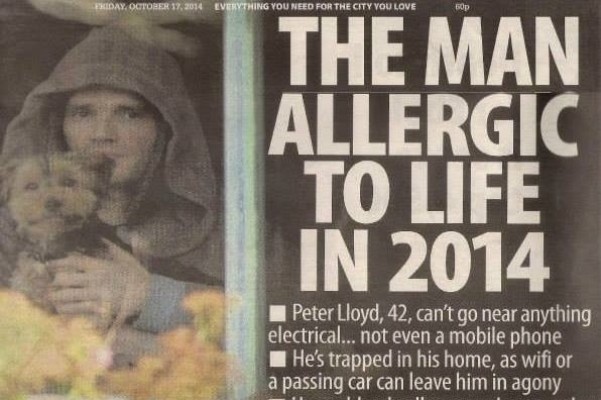

No comments:
Post a Comment